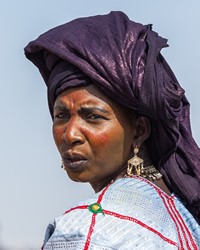Tuareg, Tamasheq in Mauritania

Photo Source:
Copyrighted © 2025
Katja Tsvetkova - Shutterstock All rights reserved. Used with permission |
Send Joshua Project a map of this people group.
|
| People Name: | Tuareg, Tamasheq |
| Country: | Mauritania |
| 10/40 Window: | Yes |
| Population: | 145,000 |
| World Population: | 980,000 |
| Primary Language: | Tamasheq |
| Primary Religion: | Islam |
| Christian Adherents: | 0.04 % |
| Evangelicals: | 0.00 % |
| Scripture: | New Testament |
| Ministry Resources: | Yes |
| Jesus Film: | Yes |
| Audio Recordings: | Yes |
| People Cluster: | Tuareg |
| Affinity Bloc: | Arab World |
| Progress Level: |
|
Introduction / History
The Tuareg of Mali belong to a larger group of Berber-speaking Tuareg who live in an area that stretches from the western Sahara to western Sudan. The Tuareg are divided into several main political groups or tribal units. Their distinguishing characteristics include the unity of their language, their alphabet which uses "tifinagh" characters, and their complex social organization.
Although the origin and early history of the Tuareg are obscure, these tribal nomads appear to have traveled down from North Africa in a series of migrations as early as the seventh century. By the end of the 1300s, Tuareg tribes had established themselves as far south as the Nigerian border.
Some call them Tuareg, others prefer the name Tamasheq. Their language, however, is Tamasheq.
What Are Their Lives Like?
At the beginning of the 1300s, salt, gold, ivory, and slave markets sprang up across Tamasheq Tuareg territory which stretched across North Africa, Europe, and the Middle East. During that time, the Tamasheq Tuareg became well known as livestock producers and merchants in the Saharan and Sahelian regions.
In the Southern Sahara, many Tamasheq Tuareg, particularly those from the Sub-Saharan African classes, are now settled farmers living in villages surrounded by grain fields. Since farming is seasonal work, many of the young men also take jobs as blue-collar workers in Nigeria, Ghana or Cote d'Ivoire for part of the year.
Tamasheq Tuareg nomads live in small, lightweight, leather tents or grass huts. A tent is usually about 10 feet long and 10 to 15 feet wide. A household can pack its goods on the backs of two camels, while one or two donkeys carry their odds and ends.
Tamasheq Tuaregs wear clothing that is loose and lightweight. In direct contrast to Arab custom, all of the men wear veils called tidjelmousts; the women do not wear veils. The most preferred tidjelmousts are dyed indigo, though many men wear black. To show respect, the men always cover their mouths, noses, and foreheads while in the presence of foreigners or their in-laws.
What Are Their Beliefs?
Though the Tamasheq Tuareg are virtually all Sunni Muslim, they have a reputation among other Muslims for being lukewarm in their faith. They practice a passive form of Islam, infused with folk beliefs and magic. Most do not even celebrate the most important Muslim fast of Ramadan.
What Are Their Needs?
There are few known Tamasheq Tuareg believers in Mauritania. Prayer is the key to reaching these precious people with the gospel of Jesus Christ.
Prayer Points
Pray that missions agencies and churches will accept the challenge of adopting and reaching the Tamasheq Tuareg.
Pray that gospel broadcasts will soon be produced in their language.
Pray that the small number of Tamasheq Tuareg believers will rise to the challenge of taking the gospel to their people.
Pray that God will grant wisdom and favor to mission agencies focusing on the Tuareg.
Ask the Lord to save key leaders among the Tuareg who will boldly declare the gospel.
Ask the Lord to raise up strong fellowships of believers among the Tamasheq Tuareg.